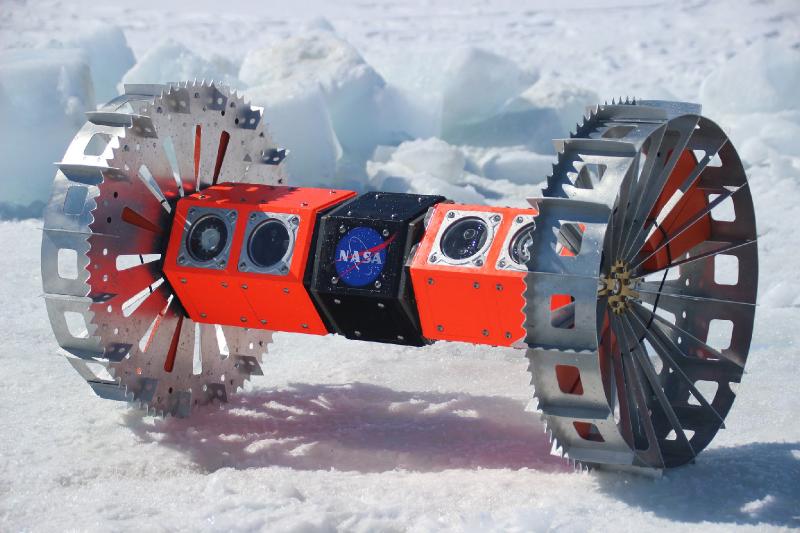This Robot’s Journey to an Icy Alien Moon Starts Beneath Antarctica


A video of the Bruie rover is here .

But had they leapt in, the penguins would have discovered not a seal, but a robot.
In November, scientists and engineers from NASA’s Jet Propulsion Laboratory successfully field tested Bruie — the “Buoyant Rover for Under-Ice Exploration” — beneath the ice of eastern Antarctica. The remotely operated rover was built to crawl along the underside of sea ice and ice shelves. These tests on Earth have a long-term goal of one day seeking evidence of life beneath the thick frozen shell covering Jupiter’s ocean moon of Europa. Beneath that ice is three times more liquid water than can be found in all the oceans on Earth.
It will be years before a spacecraft from Earth lands on Europa, which was most closely studied by NASA’s Galileo mission in the 1990s. The next robotic probe to visit that world will be Europa Clipper, scheduled to launch no sooner than 2025. When it arrives some years later, that spacecraft will orbit Jupiter and encounter Europa dozens of times at different angles to thoroughly scan and map the moon, considered one of the best candidates in our solar system to be inhabited by some form of extraterrestrial life.
Any future for a lander visiting the Jovian moon is uncertain. But that hasn’t stopped NASA’s engineers and scientists from developing technologies to aid its mission.
“Getting a vehicle like the buoyant rover and other submersibles in the ocean of Europa is the long-term vision for what we hope to one day accomplish,” said Kevin P. Hand, the project’s science lead from the Jet Propulsion Laboratory. “It’s going to come after Clipper and a lander on the surface. These precursor missions would set the stage for getting through the ice and reaching the ocean.”
Bruie has been in development since 2017. The rover is the marriage of Jules Verne-like inventiveness and the simplest machine possible to build: little more than an axle and two wheels, each about the size of a large pizza.
As its expanded name implies, Bruie floats. The sea presses it against the belly of the ice shelf, and as the rover crawls along, its sensors collect data. During its Antarctic field tests beneath the ice of O’Brien Bay near Casey Station, an Australian base on the eastern part of the continent, the rover successfully endured three frigid three-hour deployments.
A fourth, critical test kept it submerged beneath the ice for 42 hours and 30 minutes. Andy Klesh, the project’s lead engineer, drove the rover using a laptop. While the rover can be piloted via satellite connection, during this mission, Dan Berisford, a mechanical engineer, carefully fed it a thin yellow tether.
On Europa, the real action is in its ocean; if at last the Jovian moon does get a rover that could get beneath its surface, it makes sense that the robot would crawl on the underside of its ice shell. The radiation chemistry and geophysics of Europa’s surface might provide a mechanism for providing oxygen for life in its depths.
To study such life, any undersea rover would need to be noninvasive.“While the thrusters of a normal underwater remote-operated vehicle can jet-blast delicate algaes off the bottom of ice sheets during close encounters, Bruie gently tiptoes beneath them,” said Daniel Arthur, a technologist who works with Caltech and the University of Western Australia.
The rover analyzes the ice-ocean interface passively and at consistent distances, drawing little power — especially relative to submarine-type drones. “Power will be in short supply on Europa,” Dr. Arthur said, “and we don’t want a propeller obliterating humanity’s first encounter with extraterrestrial life.”
The ice-ocean interface on Earth is a zone where physics, chemistry, and biology all interact, said Alison Murray, an Antarctic scientist at the Desert Research Institute in Nevada. On our planet, the zone is rich with microorganisms. “We want to understand the habitability of these interfaces as well as the diversity of life that calls them home,” said Dr. Murray. “In both cases, we can better understand whether this interface in the dark waters of Europa might actually be able to support life.”
Dr. Hand hopes that work on devices like Bruie can drive development of robots to explore Earth’s cryosphere, where ice meets oceans.
“It is my hope that exploring Europa’s ocean can serve as a forcing function, from an engineering standpoint, to build those kinds of capabilities to get the same work done on planet Earth,” he said.



Finding exolife (especially in our solar system) could substantially change our understanding of the concept we call 'life'.
Indeed. Not to mention it would be a momentous occasion in science to discover life outside of Earth and open up new possibilities of where to search for life.
Agreed. Finding just one form of primitive exolife changes the question from ‘are we alone’ to ‘where else has life emerged?’. A game-changer which would no doubt embolden our searches for signs of intelligent exolife in the cosmos.
Ok, say we find life, how are we going to handle things like colonization?
If we find life on Mars, are we going to ban ourselves from living there or will we go ahead and mess the planet up so we can live there, which could mean the extinction of the life there already?
Excellent questions. And the same might be asked of alien life that "discovers" the Earth...
Id say first determine if a given planet (or moon) is habitable for humans.
May not be much there to go extinct. Either way, colonizing Mars would require building artificial habitats.
I wonder which will be easier to terraform in the year 2200: Europa... or... Earth...
Of course one would hope that we would approach it responsibly. But, ultimately, we will visit and explore to understand the (undoubtedly micro organism) life (if it is found). Eventually we might colonize and, in spite of our efforts, will likely change the ecosystem.
I would hope at that point, Earth won't need extensive terraforming. More like habitat repair.
What I would want to see happen is study it and if it is useful use it, if not, well it had several billion years to become something, it didn't so move over
By 2200, I would hope that we would be in space by then and the only ones left on Earth would be the meek.
This is one of my points about if there is life on Mars, if it's worth no more than a scientific curiosity, then instead of artificial habitats, maybe direct a few asteroids into the planet in such a way as to slow the Martian day down to 48 hours to get more heat gain from the sun to get water into the atmosphere and increase atmospheric pressure.
I doubt that would work. Terraforming Mars is probably either not feasible or possible.
Heresy!
Mars Trilogy, Kim Stanley Robinson
I'm thinking rotating orbital habitats are going to be the way to go.
Terra-forming Mars is probably either not feasible or possible. Yet.
Don't forget we'd need a biblical flood to tilt that planet's axis, so it will have seasons
Even if we could terraform Mars someday, we'd still only have .38G of gravity. We don't know what that would mean for long-term habitation, what physical effects it might have on fetal or childhood development.
It would be amazing to visit and study Mars, but living there permanently might not be such a good idea. Big rotating space stations would probably be a better way to go. We could have simulated gravity at or close to 1G, an almost unlimited supply of direct (unfilted) solar energy, and no local contaminants like the perchlorates on Mars that might make growing food in Martian soil an exercise in futility.
I wonder what Uranus did to deserve a flood big enough to flip it all the way over on its side? What is it, like 98 degrees of tilt? Something like that.
but living there permanently might not be such a good idea.
The problem is someone will have to. To get the raw materials to build space stations we need to mine somewhere preferably with lower gravity, like Mars or the moon, where heavier loads can be lifted into space. Solar power isn't going to get us beyond our own solar system, so I would propose refining the energy that earth has and supply space refueling stations around the earth, moon, and Mars. The same idea for space to simulate 1G could also be used as a land based habitat on Mars.
Definitely the Moon, at first. Other places later on, maybe even as far out as the Kuiper Belt (there's loads and loads of water out there). And not just for the initial build, but also for expansion, and the periodic replenishment of certain resources.
All of that could just be a job, though, with only temporary excursions in zero or low G. Much of the work could likely be automated, or performed with remotely-operated machinery.
Resource gatherers wouldn't have to live permanently in low gravity, and their pregnant wives and young children wouldn't have to experience it at all if they didn't want to (just for fun or something).
Oh, I'm not even thinking about interstellar travel. We need to learn how to walk before we can run.
For a large facility that would probably be much more trouble than it's worth.
Only time, and technology, will tell.
I agree. It is one thing to simulate gravity where there is none. On a planet we would be supplementing the existing gravity. Tough gig.
I wonder what the deep scans beneath the surface will reveal? I wonder if it is capable of such.
It doesn't appear to be designed to go deep.
I'm thinking sonar scans which can be done even from the under-ice surface. As small as it is they may not have designed a transponder into it opting for using the extra space for power cells. Just seems like a long way to go without doing a mapping of the ocean floor.
Sonar makes sense.
Note that a key design factor is low power requirements and minimal disruption by movement. They are focused on finding exolife near the surface. Also, they might have communication issues if the Bruie went too deep. Just speculating.
Cool!
Driving around on the underside of Europa's ice? That's a great idea.
They'd better sterilize the hell out of it, though. A liquid water environment would be a lot more hospitable to hitchhiking extremophiles from Earth than say, the Martian surface is.
It would be monumentally tragic to discover life on Europa and then accidentally introduce some random Earth microbes that wipe it out.
The trip over will be rather hostile to life if they allow the rover to be exposed to space.
You know, I used to think that would be enough to kill anything, but I'm not so sure anymore.
The Tardigrades can survive in space. Although not 100%, space is pretty lethal.
Tardigrades are what I had in mind. If they can survive some time in space, we may find that other species can manage, too.
Surely there will be radiation shielding around sensitive circuitry, though. That's probably where the little buggers would hide.
I know NASA assembles their probes in sterile clean rooms and tries to prevent contaminating destinations, but I'm almost positive that I read somewhere that they can't be 100% sure.
You are correct. Tardigrades can survive in space. But I'm not sure for how long. They are resilient little buggers.
It's funny, on the front page the word just shows up as "igrades" - gotta love the filter
Thing is, life is the single biggest threat to life. Life kills life more than anything else. We have to be careful what we bring back here too.
True enough.
The possibility of harming or destroying what would be the biggest scientific discovery of all time doesn't concern you?
Yes it would be a great scientific discovery, but also wouldn't finding out that our RNA/DNA could survive elsewhere, other than earth, be a great scientific discovery?
Also are we going to have a "prime directive" and hamper our future space exploration and colonization or will we be like the Klingons and Romulans?
Well, I wouldn't think so. Doesn't it kind of go without saying that life can survive in environments that suit it? It doesn't really matter where the environments are. If there are similar conditions and an energy source that an organism can make use of (food), then the organism can survive. It wouldn't strike me as much of a surprise. I mean, it's to be expected, right?
I certainly hope so. I would much prefer a future with the ethics of the Federation than those of the Klingons or the Romulans.
And replicators, too. I reallllllllly want replicators.